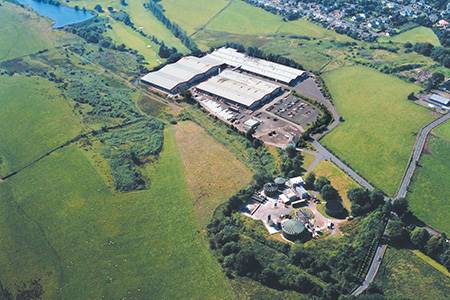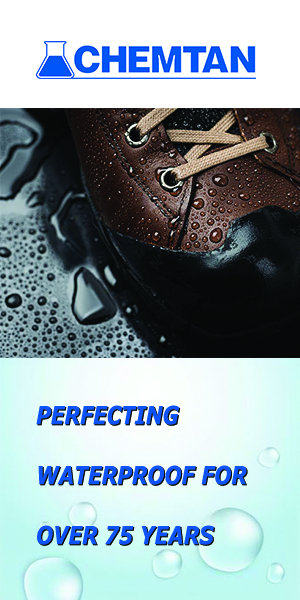Bridge of Weir Leather, Renfrewshire, Scotland

Bridge of Weir (BoW) Leather, part of the Scottish Leather Group, was founded in 1905 in a former blanket mill. In the 104 years that have followed the company has become involved in a long list of prestigious projects, including making leather grips that helped Ben Hogan win The Open golf championship in 1953 and Arthur Ashe triumph at the men’s singles at Wimbledon in 1975. Its leather has also been incorporated into iconic buildings such as the British Library in London and the Burj al Arab seven-star hotel in Dubai. However, its main focus has always been on transportation and in particular on motor cars.
Bridge of Weir (BoW) Leather concentrates most of its efforts on the automotive industry. The company is proud of its heritage, having supplied leather upholstery for the world’s first mass-produced vehicle, the Model T Ford. Founder, Arthur Muirhead, had a vision that transportation in general would provide a good target market for a supplier of high-quality upholstery leather produced, in Bridge of Weir’s case, from top-end hides from Scottish and Irish cattle. One of the first contracts he won was to produce leather for the famous ocean liner, the RMS Lusitania, which was built at nearby Clydebank and launched in June 1906. Bridge of Weir leather has also gone into trams, buses, railway carriages and, later, aeroplanes, confirming Arthur Muirhead’s vision that there would always be demand for luxury and comfort among travellers, a demand that leather can help fulfil.BoW still has some clients in the contract furniture sector—offices and, occasionally, hotels—but it is at the luxury end of the car market where the company now does most of its business, supplying full or pre-cut hides to 20 current production models for brand-names that include Lincoln, Mercedes, Aston Martin, Jaguar and Saab.
Fisker Automotive has specified Bridge of Weir for its new, California-designed, hybrid electro-petrol sports car, which it will launch in early 2010. For Iain McFadyen, BoW’s managing director, car brands that are keen or green, as Fisker certainly is, regard BoW leather as a plus-point because of the tannery’s commitment to the environment.
Hard times
In recent months, of course, the automotive industry has had to endure leaner times, but this has not shaken Bridge of Weir’s conviction that its focus is correct. Jonathan Muirhead, grandson of the founder and present-day chairman of the Scottish Leather Group, says he has no doubt that a decision the company took in the late 1980s to exit the shoe leather market was the right one. “Strategic decisions are always interesting,” he comments, “but we got out of shoe leather at what I think was the right time. If anything, I’d say we possibly stayed in footwear for five years too long. I don’t think anybody has been immune to the decline in sales of new cars, and we certainly haven’t. Since early September 2008 our sales to automotive companies have fallen by 50%, which is in keeping with the fall in sales of new cars right across the board. Leather has taken its share, but there has been a fall in demand for all cars in general, not for cars with leather in isolation.”
He accepts that markets like the UK may suffer a more acute fall in sales of luxury cars because many of the buyers at this end of the spectrum were people who earned huge bonuses working in the financial sector, the hardest-hit area in the 2009 downturn. At BoW, this led to shorter working weeks between mid-December and early May. Now the workforce is back full time, which Mr Muirhead interprets as a sign that “we may have come off the bottom”.
He has not enjoyed the experience and points out that, for BoW as a supplier, one of the most startling developments has been the speed with which credit insurance has become difficult to secure. It’s hard for the leather manufacturer to get credit insurance now on companies that, two years ago, were regarded as blue chip. A lack of credit at consumer level has also hurt the Scottish company. The chairman explains that, in his mind, you can divide consumer products into two categories: those that you can buy with cash you have in your pocket, and those for which you need credit. Cars and furniture fall into the second category, while shoes and leathergoods, for the most part, fall into the first category.
But Mr Muirhead remains unfazed. “This is my fourth recession,” he says, “and we’re still here. We had to move the core workforce onto short time, which was hard, and we’ve cut back on agency workers, but we made no one redundant. It’s expensive to make people redundant, and especially expensive to re-skill them when things pick up again. People knew what was happening, because at least this time the recession has been widely publicised.”
A family business
Bridge of Weir regards itself as “an outpost of the leather industry these days”, as there are so few companies still producing leather, not just in Scotland but in the whole of the United Kingdom. However, the company now considers itself to be a global supplier. In 2007, it formed a strategic alliance with US firm Irvin Automotive to set up a joint-venture cutting facility in Mexico. It is also preparing to launch formally a new joint venture in Shandong Province in China, which has the name Zibo Polygrace Bridge of Weir Leather Company. But its roots remain firmly in the Renfrewshire village that gave the tannery its name.
It’s interesting that the family connection underpinning the company and its link to the Scottish Leather Group is still in place, and still strong. Other family firms, all over the industry, have failed to make it this far.
Jonathan Muirhead speculates that, the world over, one of the challenges facing the leather industry is that consolidation—a natural development in business—seldom happens because the sector is full of small family firms that are too proud to merge. In some cases, he believes pride got in the way of “proper corporate development”, with companies striving to be the biggest and to produce the largest volume of leather without stopping to ask themselves if they were able to make any money in the process.
“We won’t take the profit out of this business,” he insists. “We continually invest in the best equipment available. Leather is capital-intensive, but we have to try to stay one step ahead and to look the whole time to see where profit can be made.”
Lean manufacturing
One of the consequences of spending so much time examining the world of motor cars is that BoW is now a loud and proud advocate of lean manufacturing, producing leather in keeping with just-in-time principles, eliminating waste wherever it finds it and striving to achieve continuous improvement, small step after small step.
That said, managing director Iain McFadyen acknowledges that the nature of leather makes it impossible to treat it as just another engineered component to add to the automotive assembly jigsaw. Different types of leather make different workflows appropriate and, sometimes, essential, because, to give just one example, hides of different thickness dry at different rates. And matching the colour of finished leather upholstery to the palettes that car brands specify and offer to consumers is an art in itself.
BoW’s sales manager, Dale Wallace, has responsibility for taking the tannery’s own colour trend predictions around its automotive clients to try to help them prepare for changes in consumer demand. He says: “In the automotive industry, there are two ways into the customer. You can develop a product that the customer genuinely wants, or you can go in on price. We believe it’s better to add value, and this has opened many doors for us.”
The trend presentation comes together every autumn and involves some clever animation and specially composed music to go with the themes and colours BoW picks out. The 2008 presentation had the title ‘Beyond’ and put considerable emphasis on leather’s place, beside stone, wood, wool and so on, in the panoply of natural materials.
Something else Mr Wallace does is to take a film crew to major motor shows such as Geneva, Frankfurt, London and Los Angeles to record feedback from consumers about the upholstery choices automotive companies have made. This exercise has given him documented evidence of real members of the public saying that they feel strongly that leather seats offer comfort, durability and beauty. They love the smell of leather and believe it shows richness. Visitors to the Los Angeles motor show frequently expressed the view that the leather in European cars was, in general, of a higher standard than the leather they were used to seeing in US-made cars.
“We make leather that looks like leather,” Jonathan Muirhead says here by way of explanation. “And just as we have seen labelling appear on footwear showing that they are made of leather, we’d like to do the same with car seats, and even with furniture. If leather is made so uniform and so similar that it looks like plastic, the public is being tricked to a certain extent. It’s clear to us that the public wants leather to appear more natural. That’s how leather will survive.”
The standard batch that the company runs on behalf of clients is 260 hides, but it has found itself in the past tanning one hide to colour match the choice of a single customer of top-end car companies such as Aston Martin. At this end of the market, money tends to be no object, so going a little further to have your new car’s upholstery in your corporate colours or in the colours of your favourite football team is a step some are happy to take.
Scotland and the environment
Scotland is serious about sustainability and the environment; it’s easier for it to be so in these post-industrial days in which the large coal mines and steelworks are long-closed. All the same, the Scottish Environment Protection Agency (SEPA), as the country’s environmental regulator, is an influential body and, in its determination to protect and improve the environment, has subjected the remaining major industrial operators throughout the land to regulation under Integrated Pollution Prevention Control and operator performance assessments to measure the level of pollution hazards that they represent.
SEPA publishes the score online, out of 30, that every company subject to assessment achieves and gives details of any incidents that have provoked an ‘unsatisfactory’ tag. BoW has achieved the second-highest mark in the country, with 26 out of 30.
The company’s environment director, Dr Warren Bowden, also points out that, although tanneries always require large amounts of water, Scottish Leather, at group level, is currently using 50% of the industry standard, even though the facility at Bridge of Weir has its own dam and Scotland, on the whole, is far from short of rain. “In spite of our situation, we’re using the same amount of water as tanners in semi-arid countries,” he says.
On top of this, though, the company believes that, with the proposed launch of its own combined heat and energy facility, it is on the brink of a major environmental breakthrough at BoW Leather. Dr Bowden’s conviction is that the waste the tannery is producing has a high enough calorific value to be able to produce more heat energy than BoW requires to produce leather in the first place.
This point deserves careful consideration. The implication is that tanneries can be zero-waste, energy-neutral operations. If Warren Bowden and the management team at BoW that has backed him are correct, tanneries, renowned the world over for their potential to pollute, can actually be model industrial operations for the twenty-first century. Production can increase, because although the amount of waste generated would increase, too, so would the amount of energy the operation would recover.
Dr Bowden is quietly passionate about the concept. He says: “Energy is an issue, and landfill is an issue, for us and for everyone. With the thermal energy plant in place, we’ll be putting practically no waste into landfill, which is very important because there are, at present, only 12 sites in the whole of Scotland that we could use, and many of the 12 are trying to put incinerators in place to increase their capacity. However, local residents and Scottish ministers have objected.”
Iain McFadyen adds that, over and above the obvious transportation costs and landfill charges, landfill tax in Scotland is going up by £8 per tonne each year between now and 2013. Current landfill tax is £40 per tonne, plus tipping fees and transportation costs. The managing director points out that, as landfill space becomes scarcer, these prices are certain to go up further. The thermal energy plant appeals to him because it means BoW can fix its own costs on energy and waste management and free itself from the intense volatility affecting prices in these two areas of the business. “This, in turn, will help us to be more competitive,” he adds.
There is more to this. BoW aims to have the new plant up and running by the start of next year. At current rates, the tannery will be eligible to receive £40 an hour from the Renewable Obligations scheme that exists in Scotland, as in other countries, to encourage industry to use energy from renewable sources.
The environment director goes on to say that the Scottish Leather Group has already worked hard to reduce the number of kilowatt hours it consumes in producing a square-metre of finished leather. Dr Bowden puts the figure at 15 at the moment and offers 47 as the industry standard. “We’re using one-third of the industry average at the moment,” he says, “but the new thermal energy plant means we can halve the amount of energy we use, which will be a tremendous help in enabling us to achieve the goal of making more and more, using less and less.”
The proximity principle, eliminating waste where the waste is generated, is one that the authorities are keen on, but BoW Leather has, naturally, also had to put its thermal energy plant plans out for public consultation, resulting, much to the group’s surprise, in no objections at all.
Group chairman Jonathan Muirhead adds the caveat that the proximity principle still means the authorities want to be sure local people will be able to see, hear and smell little of what’s going on, so BoW, having picked a secluded spot on the site, is preparing to plant more trees to screen the thermal energy plant. Even the choice of tree has become a matter of consultation, with one local resident suggesting that birch was the best bet for blending in with the local environment. BoW is happy to go with that recommendation.
The tanning company believes the objection-free consultation over the thermal energy plant is the fruit of a strong, open, ongoing relationship with the local community. It is in the habit of talking through any new ideas with local politicians first, gauging their reaction and, ideally, using their support to put the message over to local people and this method is working well.
“The point is that we want to stay here,” Mr Muirhead insists. “Our business is based on using hides from cattle from this part of the world. Around 50% of the hides we use are from Scotland. The other 50% comes mostly from Ireland, with some from England. For five or six years now, we’ve been dealing directly with the abattoirs, rather than with traders. Those abattoirs are here, so we want to be here too; we don’t want to move to eastern Europe, the Far East or anywhere else. Besides, we are part of the fabric of this community. I was born here and I know most of the people in this community. That means we have no choice; we have to be good neighbours.”






























